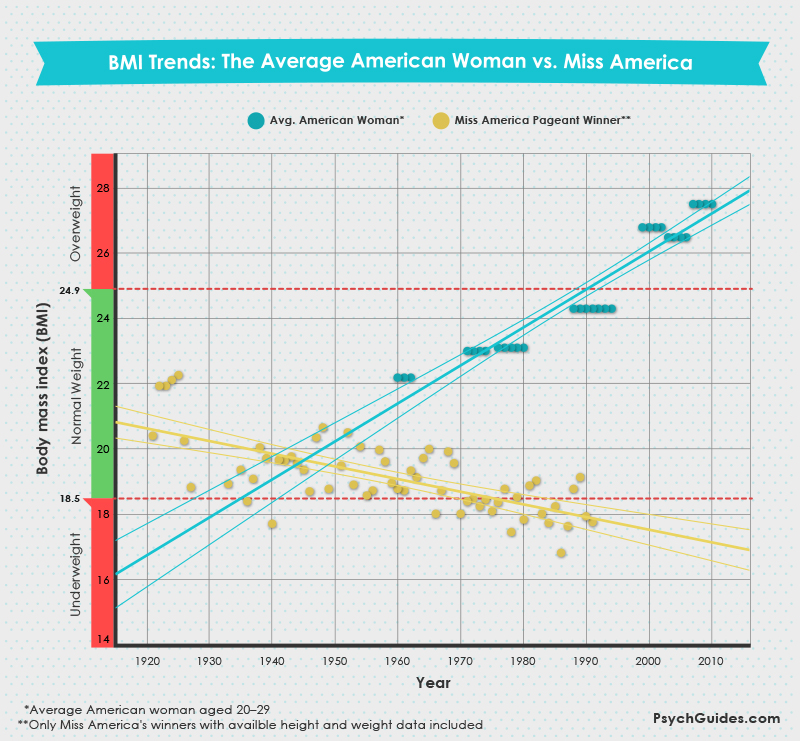Miss America BMI
(H/t to @roreiy for bringing this to my attention.)
The following provocative figure, taken from a page on “The Ideal Body Image and BMI”, has gone mildly viral recently:

Credit for this image goes to PsychGuides.com, who have requested that I “link back to the original source, which allows readers to learn more about the additional research as well as the methodology used for this project”.
Without going into the rhetoric or argument of the figure, I thought it was worth quickly replicating it from the available data to clear up some ambiguities. This should also save effort for anyone who wants to take a deeper dive into the subject.
I’m using a Miss America height/weight data set that was prepared, or at least made available, by Todd Swanson. The source for this data is from the accompanying website for the American Experience documentary about the pageant.
socket <- url("http://www.math.hope.edu/swanson/data/miss_america.txt")
ma.dat <- read.table(socket, skip=5, header=TRUE, na.strings=c("*"))
ma.dat[ma.dat$year > 1991,]## year name state age height weight
## 65 1992 Carolyn_Sapp HI 24 70 NA
## 66 1993 Leanza_Cornett FL 21 NA NA
## 67 1994 Kimberly_Aiken SC 18 NA NA
## 68 1995 Heather_Whitestone AL 21 NA NA
## 69 1996 Shawntel_Smith OK 24 NA NA
## 70 1997 Tara_Dawn_Holland KS 23 NA NA
## 71 1998 Kate_Shindle IL 21 71 145
## 72 1999 Nicole_Johnson VA 24 69 133
## 73 2000 Heather_Renee_French KY 24 66 NA
## 74 2001 Angela_Perez_Baraquio HI 24 64 118
## 75 2002 Katie_Harman OR 21 63 110I print those post-1991 entries because they don’t show up in the PsychGuides.com figure. There is a note about this:
The average height and weight of winners was sporadically available up until 2002. Using the height and weights that were available, we were able to calculate BMIs for each winner.
However, the data is available for the 1998, 1999, 2001, and 2002 winners. One possibility is that whatever software they were using choked on the first */NA it encountered.
Moving on, I apply the standard BMI formula for height in inches and weight in pounds.
ma.dat$bmi <- ma.dat$weight / (ma.dat$height ** 2) * 703Another methodology note mentions that “information on the average woman for each set of years was available through the Centers for Disease Control (CDC)”. Tracking this down required looking into three separate reports.1 In all cases, “average” is taken to be the mean.2 Also, in all cases, we’ll be looking just at data for US women aged 20–29.
From Table 10 in CDC report “Mean Body Weight, Height, and Body Mass Index, United States 1960–2002”, we have:
us.year <- c(1960:1962,1971:1974,1976:1980,1988:1994,1999:2002)
us.bmi <- c(rep(22.2,3),rep(23.0,4),rep(23.1,5),rep(24.3,7),rep(26.8,4))From Table 14 in CDC report “Anthropometric Reference Data for Children and Adults: United States, 2003–2006”, we have
us.year <- c(us.year,2003:2006)
us.bmi <- c(us.bmi,rep(26.5,4))Unlike the first report, this one also contains quantiles for BMI. As a quick summary, for 2003–2006, the (10%, 50%, 90%) quantiles are (19.4, 24.4, 35.9).
Finally, from Table 14 in CDC report “Anthropometric Reference Data for Children and Adults: United States, 2007–2010”, we have:
us.year <- c(us.year,2007:2010)
us.bmi <- c(us.bmi,rep(27.5,4))For 2007–2010, the (10%, 50%, 90%) quantiles are (19.9, 25.3, 38.0).
Out of caution and pedantry, when I assemble all of these observations into a data frame, I reweight them to compensate for the difference of lengths in the periods covered. Even though it is visually helpful to see three separate points for, e.g., 1960, 1961, and 1962, the code computing a linear trend should not treat them as (unusually consistent) independent observations.
us.dat <- data.frame(year=us.year, bmi=us.bmi)
us.dat$weight <- c(rep(1/3,3),rep(1/4,4),rep(1/5,5),rep(1/7,7),rep(1/4,4),rep(1/4,4),rep(1/4,4))With all the preliminary work done, the two data sets can be plotted using a slightly inelegant invocation of ggplot2.
require(ggplot2)## Loading required package: ggplot2ggplot(us.dat, aes(x=year,y=bmi,weight=weight)) +
geom_point(color="skyblue") +
geom_smooth(method="lm",fullrange=TRUE) +
geom_point(data=ma.dat, aes(x=year,y=bmi), color = "navy") +
geom_smooth(data=ma.dat, aes(x=year,y=bmi), method="loess") +
xlab("Year") +
ylab("BMI")
BMI Trends: The Average American Woman vs. Miss America
There’s really no good reason to fit a linear trend to the Miss America data, especially given the new observations, so I instead use LOESS. There’s really, really no good reason to fit a linear trend to the American average data, so I leave that choice intact.
These reports summarize results from NHANES (National Health and Nutrition Examination Survey), which appears to be filled with fascinating longitudinal data.↩
Incidentally, because BMI is nonlinear in weight and height, the mean BMI is in general not equal to the BMI computed from mean weight and mean height. I should have paid more attention to be sure of this, but I strongly expect that the CDC is doing the right thing and reporting the mean of BMIs and not the BMI of means.↩